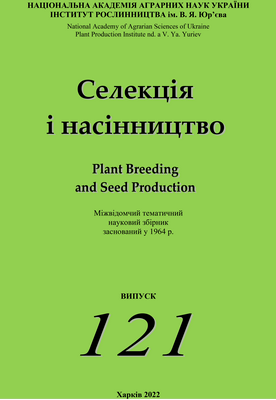Оцінка вихідного матеріалу соняшника за селекційно цінними ознаками
DOI:
https://doi.org/10.30835/2413-7510.2022.260986Ключові слова:
соняшник, лінії, селекція, продуктивність, життєздатність пилку, індексАнотація
Мета дослідження. Визначення селекційних та основних корисних господарських ознак самозапилених ліній соняшника в умовах східної частини Лісостепу України.
Матеріали і методи. Вихідним матеріалом для дослідження були 14 самозапилених ліній соняшника різного генетичного походження. Польові і лабораторні дослідження проведено за загальноприйнятими методиками. Життєздатність пилку фертильних ліній соняшника визначали тетразольним методом.
Обговорення результатів. Серед досліджуваних генотипів соняшника було виділено п’ять генотипів: Сх808А/Х1002Б, Сх808А, Х785В та Х06135В, які в умовах східного Лісостепу України мали найвищі показники продуктивності кошика в межах 30,0–57,8 г (1,7–3,3 т/га). Підтверджено результати інших науковців щодо відмирання листя та відсутності кореляції між ознаками висоти, ІЛП та продуктивності (r=0,05; -0,11; -0,13 відповідно). Відмічається, що ІЛП має важливе значення для формування олійності насіння та має з нею негативну кореляцію r=-0,57. За періодом розвитку сходи-цвітіння найменш тривалий період розвитку має лінія Сх808А – 60 діб, а найбільш тривалий ХНАУ1133В – 75 діб. Отримані лінії соняшника методом мутагенезу мають низькі показники врожайності (0,5 т/га). За показником життєздатності пилку виділено лінію Х06134В, яка продукує найбільшу кількість життєздатного пилку – 64,5 %
Висновки. Визначено особливості росту і розвитку ліній соняшника в умовах східної частини Лісостепу України. Проведено оцінку основних селекційних та корисних господарських ознак ліній соняшника. За результатами дослідження виділено генотипи Сх808А/Х1002Б, Сх808А, Х785В і Х06135В з найкращими показника продуктивності та якості. Виділено генотип Х06134В, що продукує найбільшу кількість життєздатного пилку.
Посилання
State register of Plant Varieties suitable for distribution in Ukraine for 2022. UIPVE. Last accessed: 05.05. 2022. https://sops.gov.ua/derzavnij-reestr.
Makliak KM, Kyrychenko VV, Brahin OM. Selection of new lines-fixers of sunflower sterility. Sel. nasinn. 2009; 97: 13–19. https:// doi.org/10.30835/2413-7510.2009.77036.
Kutyshcheva NM, Shudria LI, Sereda VO. Morphological characteristics of perspective sunflower lines. Naukovo-tekhnichnyi biuleten Instytutu oliinykh kultur NAAN. 2017; 24: 85–93.
Mykhailenko V, Kyrychenko V, Bragin A, Chuiko D. generation, evaluation, and prospects of further use of mutations based on new homozygous self-pollinated sunflower lines. Genotoxicity and Mutagenicity-Mechanisms and Test Methods. London : IntechOpen; 2019. P. 43–57.
Syvenko OA. Manifestation of the heterosis effect in f1 hybrids and combining ability of sunflower lines – pollen fertility restorers. Visnyk Tsentru naukovoho zabezpechennia APV Kharkivskoi oblasti. 2015; 19: 161–170.
DeGreef MG, Prasifka JR, Koehler BD, Hulke BS. Registration of oilseed sunflower maintainer germplasm HA 488, with resistance to the red sunflower seed weevil.Journal of Plant Registrations. 2020; 14(2): 203–205. https:// doi.org/10.1002/plr2.20035.
Makliak KM, Kyrychenko VV.Resistance of sunflower starting material to new wolf races (Orobanche cumana Wallr.).Sel.nasinn. 2012; 102: 16–21. https:// doi.org/10.30835/2413-7510.2012.59808.
Kyrychenko VV, Petrenkova VP, Makliak KM, Borovska IYu.Results of sunflower breeding for resistance to major pathogens.Sel. nasinn. 2010; 98: 3–12. https:// doi.org/10.30835/2413-7510.2009.77035.
Borovska IYu, Petrenkova VP, Kolomatska VP. Influence of parental forms on resistance to phomopsis pathogen of sunflower hybrids.Sel. nasinn. 2008; 95: 18–23. https:// doi.org/10.30835/2413-7510.2008.84705.
Pasda G, Diepenbrock W. The physiological yield analysis of sunflower (Helianthus annuus L.) Part II Climatic factors. Fett. Wissenschfat Technologie. 1990; 93: 155–68.
Tahir MHN, Imran M, Hussain MK. Evaluation of sunflower (Helianthus annuus L.) inbred lines for drought tolerance. International Journal of Agriculture and Biology. 2002; 3: 398–400.
Ghaffari M, Toorchi M, Valizadeh M, Shakiba MR. Morpho-physiological screening of sunflower inbred lines under drought stress condition. Turkish Journal of Field Crops. 2012; 17(2): 185–190.
Bonciu E. Aspects of the pollen grains diameter variability and the pollen viability to some sunflower genotypes. Journal of Horticulture, Forestry and Biotechnology. 2013; 17(1): 161–165.
Mynets TV, Kyrychenko VV, Udovichenko AIu. Evaluation of sunflower fertility restoration line according to pollen-forming ability and self-fertalization. Naukovi dopovidi NUBiP Ukrainy. 2020; 84(2).
Razzaq MK, Rauf S, Shahzad M, Ashraf I, Shah F. Genetic analysis of pollen viability: an indicator of heat stress in sunflower (Helianthus annuus L). International Journal of Innovative Approaches in Agricultural. 2017; 1: 40–50.
Astiz V, Hernández LF. Pollen production in sunflower (Helianthus annuus L.) is affected by air temperature and relative humidity during early reproductive growth. Phyton. 2013; 82: 297–302.
Dospekhov BA. Methods of experimental case. Moscow: Agropromizdat, 1985. 315 р.
Methods of qualification examination of varieties of technical and fodder crops. Kyiv: Alefa, 2003. Vol. 3. 226 р.
Kyrychenko VV.Special selection and seed production of field crops. Kharkiv: Рlant Production Institute nd. a. V.Ya. Yuriev,2010. 462 p.
Pausheva ZP. Workshop on plant cytology. Moscow: Agropromizdat, 1980. 303 p.
Marinković R, Škorić D. Examination of heritability of certain quantitative traits of sunflower (H. annuus L.). Production and processing of cultivars. 1984; 1: 161–167.
Makliak KM, Sharipina YaIu, Kyrychenko VV. Investigation of dry and yellow leaf number after anthesis in common sunflower.Sel. nasinn. 2017;111: 74–87. https:// doi.org/10.30835/2413-7510.2017.104889.
Chuyko DV, Bragin AN, Mikhaylenko VO. Effect of plant growth regulators on the vegetative surface of sunflower lines. Vestnik Belorusskoy gosudarstvennoy selskokhozyaystvennoy akademii. 2021; 2: 59–63.
Chuiko D. Plant growth regulator effects on sunflower parents and F1 hybrids. Žemės ūkio mokslai. 2021; 28(2): 34–44. https:// doi.org/10.6001/zemesukiomokslai.v28i2.4508.
##submission.downloads##
Опубліковано
Номер
Розділ
Ліцензія
Авторське право (c) 2022 D. V. Chuiko

Ця робота ліцензується відповідно до Creative Commons Attribution 4.0 International License.
При розміщенні текстів статей в електронних ресурсах авторські права зберігаються за автором друкованої публікації.
Автор може не погоджуватися з правками рецензентів і редакції, мотивуючи при цьому свою точку зору.
Автор може вимагати від редакції пояснень або змін у випадку виявлення істотних помилок у його статті.
Автор може використовувати матеріали, опубліковані в журналі «Селекція і насінництво» у своїх роботах, обов’язково посилаючись на наш журнал.

